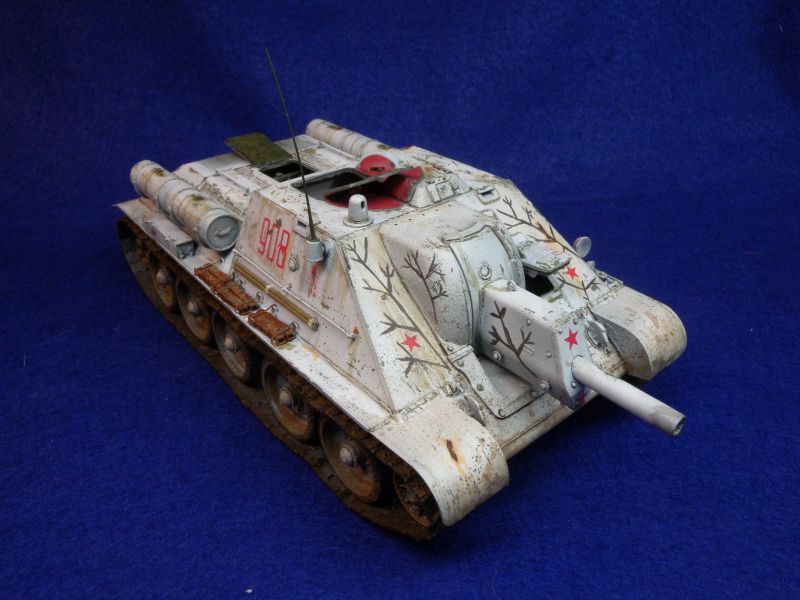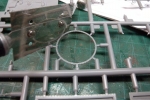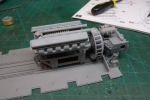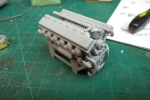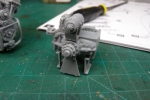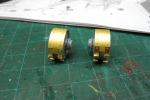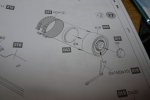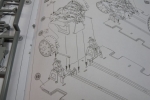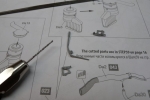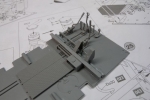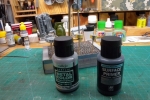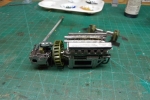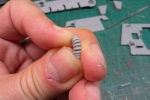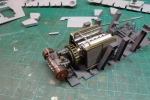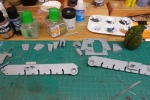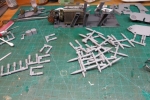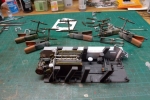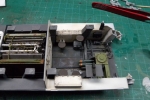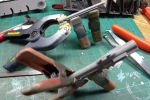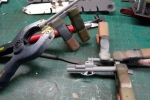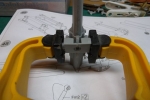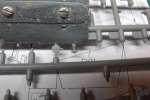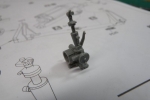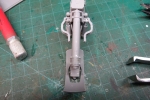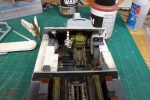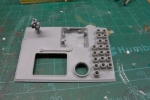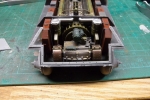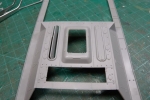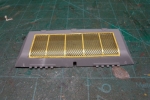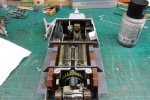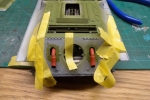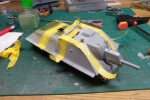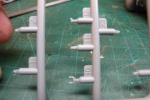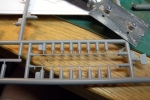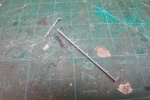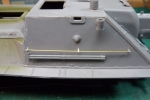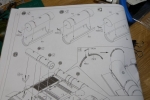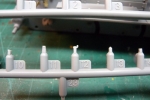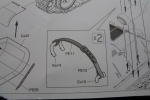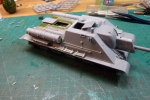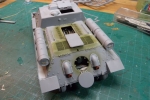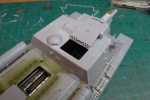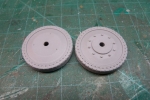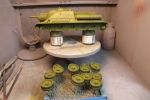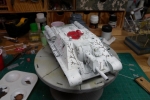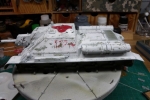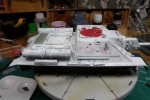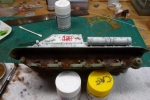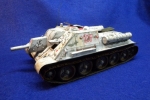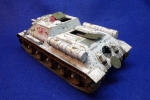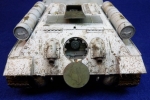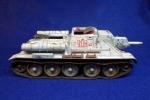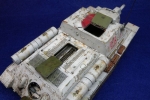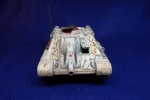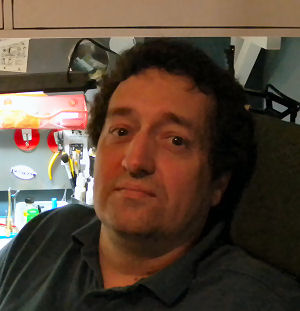1⁄35SU-122 Build
16
Comments
History
Based on the success of the German assault guns, like the StuG III, the Russian began looking at self-propelled guns as well, due to the cost reduction in building a tank with no turret. Using the already successful T-34 chassis and the 122mm M-30 gun, the SU-122 was born. The first Su-122's began rolling of the production line in December 1942. The initial production units were sent to the training center and two new self-propelled artillery regiments were created and equipped. The newly created regiments, 1433rd and 1434th, we sent to the Leningrad area as part of the 54th Army, both seeing combat in early January. The initial use of the SU-122 proved not very successful, and the regiments underwent strategy and organizational changes. Where the SU-122 proved very successful was assaults on strongholds with direct fire. It was stated that the concussion from the 122mm rounds were strong enough to blow the turret off a Tiger tank with a direct hit. In total approximately 1150 SU-122's were built prior to the end of the war. This new kit from MiniArt, featuring a full interior, represents the initial batch of the SU-122's, that would have seen combat in the battles surrounding Leningrad.The Kit
The kit from MiniArt is almost a piece of art, well detailed, including a full interior. You can find a great review of the kit here: https://armorama.kitmaker.net/modules.php?op=modload&name=Reviews&file=index&req=showcontent&id=12417. Unfortunately, my only disagreement with the review would be the complex assembly. While there are a lot of fine parts, care in removal from sprue and with patience and a little planning, the assembly is rather straight forward.The Build
The build starts off with the well done engine and interior. The engine itself goes together very well, and decent fit. Some of the piping and other parts are fine, and I would recommend a good razor saw to remove the parts from the sprues. I built the engine, transmission, turbine fan, and floor components separately for ease of painting. The floor assembly was painted using Vallejo Blue Gray, while the engine and transmission were painting with Vallejo Metal Steel. The turbine fan was painted with Ammo by Mig Russian Base. I did add some wiring to the top of the engine with copper wiring, as I planned references for early engines. Various washes using Vallejo colors were applied to the parts for that used effect. As I did the transmission separate from mounting, I had added the photo-etched brake strapping which will connect to some bracing on the floor. To ensure there was no issue with alignment, I left of the brake activation lever, and fit it after painting and mounting the brake drums. This meant I did not have to align the photo-etched part with parts Da14/15 and the tab. This made this part of the assembly some much simpler. With the floor and engine assembled, I moved onto the side walls. Parts were added, and painted with Tamiya White with washes of Vallejo Brown wash. This were a lot of detail painting comes into play. And there is a lot of ammunition stowage to be painted. The shells were painted with Vallejo Brass, and the rounds painted with Ammo by Mig Protective Green with the copper and steel stripes painted by hand. I am thinking these should have been taped and airbrushed, but I was rushing, and they are not seen clearly once the tank is assembled. The gun assembly also went very well, with good fit. There was no fill required for the breech halves, just some sanding, the barrel is one piece slide molded, so just had to sand down the seam. Again there are some fine parts, and a razor saw comes in handy. The gun was painted with Ammo by Mig Russian Base, with various washes. With most of the interior done, it was time to start on the upper hull, with the rear deck. MiniArt provides the option to leave the vents for the radiators and air intake open. I chose to close the radiator vents, as there are not seen directly, and being I was planning on a winter scheme. I did place the air intake vents in the open position, as you can just see the air filter system. Also provided, is the option for a plastic molded screen, non-visible, or a photo-etched option for the air intake. I chose to do the photo-etched option to accomplish being able to see the filters. The instruction show gluing the bracing to the screen prior to attaching to the rear deck, but with dry fitting I found this may lead to alignment problems. Thus I mounted the bracing on the outside of the deck, and fit the screen in from the inside. Prior to mounting the enclosures for the radiator and air intakes I airbrushed in some Ammo by Mig Russian Base to ensure the color got into those areas. Mounting the rear plate proved a little difficult with the fit, but with some taping to hold things in place while the glue dried, no issues. Same went for the top roof deck as well. I did find some of the surface detail, like the bolts for the rear transfer cases mold almost looking like the sprue itself. I did replace these with Meng bolt heads. The side railing has MANY sprue gates, and even delicate care with the razor saw snapped them. To resolve the issue, I cut the railings from the mounts, drilled the mounts and used brass wire. For the fuel tanks, MiniArt provided the option for photo-etched straps, but for only two of the tanks. Thus I decided to use the four tanks with molded on strapping, which does not look bad at all. I guess the option provided would allow the modeler to model a vehicle with one or two fuel tanks removed. And again the molding for the tie downs blended right into the sprues, so brass wire was used. The wheels are nicely molded, with only a little sanding to remove the seam around the wheels. With construction done, the tank was moved to the paint shop, and given a coat of my go to primer, Tamiya Fine Gray. This was followed by multiple light coats of the Russian Base. I applied the decal for the tank belonging to the 1434th Self-Propelled Artillery Regiment serving in Leningrad. The decals were applied over the green, including the faded "pink" which is provided to show the number under the white was. To ensure the number showed through, I enhanced them with a little custom mixed red. With the decals settled down, and seal with Future, it was time for the white. I applied two coat of cheap hairspray and let dry for about 30 minutes. I then applied multiple coat of very thinned Tamiya White. After drying for about 15 minutes, I began chipping. Once completed, again it was sealed with Future before the remaining decal was applied. MiniArt does not provide the decals for the "stick" camouflage on the front of the tank, so this was free handed with thinned Vallejo Black Brown and a liner brush. While not the best free hander, I was happy with the result. For weathering, I used a combination of Vallejo Acrylic and Ammo by Mig Enamel washes. The track went together relatively well, but I found some of the pins snapped on assembly of the "working" track assembly, thus I worked with them as I would Dragon Magic track. A coat of Testor glue, let set, then formed. Tracks were primed with Ammo by Mig Track Primer, followed by coats of rust washes, steel dry brushing, and a mix of pigments and Vallejo wash to add the mud. Over all this SU-122 kit from MiniArt is a great kit, full of details, both inside and out. Unfortunately, most of the interior detail is hidden, but I know it is there. I would highly recommend this kit to anyone.Comments
Beautiful paint and weathering! Can I ask what you used for reference?
AUG 28, 2016 - 07:01 PM
I used the color chart provided in the kit by Ammo by Mig, and just a few images I found on the net
AUG 28, 2016 - 07:11 PM
I was really up to build one of these. Pre-production pictures showed it with a clear upper hull. I thought....wow, all that fine interior can be visible. Alas, the production unit had NO clear upper hull. What a waste. My wallet snapped closed.
AUG 29, 2016 - 01:43 AM
Kevin, I think you hit the nail on the head. This is a modeler's kit. You build it for the build, and, even though you can't display all the great work, you know it's there.
SEP 08, 2016 - 12:10 AM
Very nice work, Kevin! Your effort really paid off, inside and out. The finished product looks amazing, and I really do like that camouflage pattern with the bushes painted on; it's something I've always wanted to try because it's so odd but interesting!
SEP 23, 2016 - 09:39 PM
Very nicely painted n finish. Im building this kit right now n will also used the same marking n scheme..
SEP 23, 2016 - 09:48 PM
Copyright ©2021 by Kevin Brant. Images and/or videos also by copyright holder unless otherwise noted. The views and opinions expressed herein are solely the views and opinions of the authors and/or contributors to this Web site and do not necessarily represent the views and/or opinions of Armorama, KitMaker Network, or Silver Star Enterrpises. All rights reserved. Originally published on: 2016-08-28 06:42:38. Unique Reads: 20960




